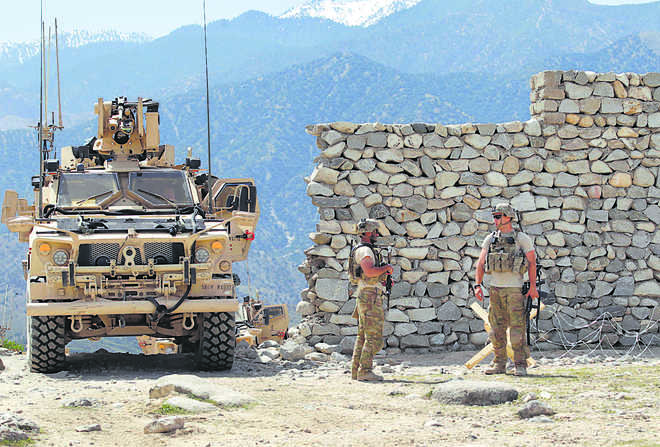
STAYING POWER: US soldiers stand guard near the site of a US bombing in Nangarhar province, in eastern Afghanistan. Photos: Reuters
Mudassir Ali Shah
President Donald Trump, breaking with his derision for the 16-year-old conflict, has finally rolled out his long-awaited policy towards Afghanistan. The presidential decision to boost troop levels is an extension of the botched approach of his predecessors.
All options that were on the table during the protracted review of America's new strategy for South Asia were bewildering. The number of extra troops for Afghanistan and benchmarks for victory are yet to be determined. The US president has virtually left the devil lying in the detail.
In his prime-time address to troops at Fort Myer, Trump embraced deeper US involvement in a military campaign he once slammed as futile. Though touted as a conditions-based regional move towards a political solution, the new plan indicates little innovation.
The presidential announcement is a success of sorts for his hawkish Defence Secretary James Mattis and National Security Adviser H.R. McMaster, who have repeatedly warned that a swift withdrawal would create a vacuum that the militant Islamic State group and Al-Qaida would fill instantly.
The way forward in Afghanistan remains blurred.
As expected, the US would mount pressure on Pakistan to shut down militant safe havens on its soil and take concrete action against the Afghan Taliban. At the same time, the US will woo India — Pakistan's arch-rival — into helping Nato battle extremists in Afghanistan.
His promise to pursue integration of all instruments of US might, diplomatic, economic and military, does not sound convincing. At the moment, the US neither has a full-time ambassador in Kabul nor a special envoy for Afghanistan and Pakistan. Many key diplomatic slots in the State Department are yet to be filled.
Importantly, Trump has come to realise that the Afghan Taliban — who control over 40 per cent of Afghanistan — are a force to be reckoned with. Some elements of the insurgent movement may also be included in a future government. But US troops will be fighting against them, nonetheless.
On the campaign trail, Trump scorned the Afghan war as an archetype of how the Bush and Obama administrations squandered billions of dollars in return for insignificant strategic gains. But he has reversed his position that American men and women in uniform should come home from that country.
During the prolonged internal debate at the White House, his national security team bent over backward to come up with suggestions acceptable to a cynical commander-in-chief. Frenzied efforts by his advisers came to fruition last week when they coaxed the President into approving the deployment of more troops. By adding more troops to the 8,400-strong US force already stationed in Afghanistan, he has toed the line of warmongering Republican legislators and military commanders, who have been pleading for expanding the campaign against militants.
However, there are no guarantees that the additional American forces would be able turn the tide, an objective that could not be realised by more than 130,000 international soldiers. The plan comes at a time when the tempo of fighting has risen steeply across Afghanistan. In the first half of 2017, civilians have died daily. The Afghan army has also been targeted in mass attacks, leaving several soldiers dead.
The so-called way forward remains blurred. It remains to be seen how Trump's team wrestles with a whole slew of complex questions — notably the cost of the new surge in treasure and blood, propping up the kleptocracy in Kabul and bringing the Taliban to the negotiating table.
Consequences of cutting bait altogether presumably forced the US leader to take a U-turn. He must appreciate the fact that Washington's fuzzy approach to winding down the conflict and riding roughshod over suggestions from regional powers will continue to hamper progress in Afghanistan.
From America's perspective, the mission must ensure foolproof homeland security. However, Trump's road map is unlikely to yield the intended results in terms of vanquishing the Taliban or blocking the return of Al-Qaida to Afghanistan. A longer and deeper commitment of US forces is unlikely to hasten an outright military victory for America — a goal that 16 years of war have failed to achieve.
As his government is still polarised and faced with popular discontent, President Ashraf Ghani has been kicking the can down the road on the key issues of institutional reforms and eradicating endemic corruption. Ubiquitous insecurity continues to be a huge impediment to the implementation of important policy decisions. As long as Kabul gropes for political and economic stability, frustrated youth will continue to swell the ranks of insurgent outfits. In the absence of a corresponding effort by Afghan rulers to set their house in order, the going will be as tough for Trump as it was for his predecessors — all playing whack-a-mole.
By arrangement with the Dawn



























